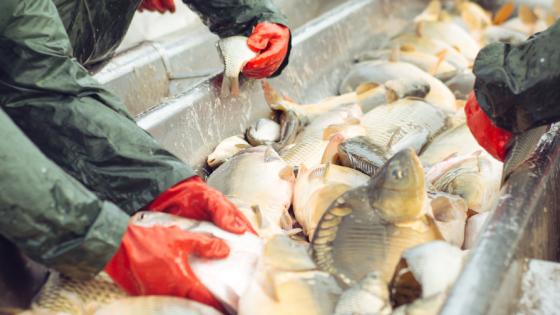With the 2030 Sustainable Development Agenda, heads of state signed on to the goal of prohibiting subsidies that contribute to overfishing, and illegal, unreported and unregulated fishing by 2020.1 The task has proved to be an arduous one as most countries, regardless of their level of development, subsidise their fisheries. Between $20-30 billion are estimated to be spent each year for that purpose.2 At the same time, fish landings are stagnating and fisheries resources are dwindling drastically (Figure 1), despite the proliferation of non-tariff measures and voluntary sustainability standards3 to promote sustainable fisheries management and development.4 The 2018 report of the Food and Agriculture Organization (FAO) on the state of world fisheries and aquaculture indicates that about 93% of world’s marine fish stocks in 2015 were either maximally sustainably fished or overfished. Moreover, most stocks remain unassessed, and more than half of monitored fisheries are depleted to the point of yielding little or no catch.
Figure 1 Fish catches and fish stocks sustainability
Sources: Authors’ calculations based on OECD (2019), Fish landings (indicator). doi: 10.1787/93a69a82-en (Accessed on 10 October 2019) and FAO (2018).
Note: Fish landings (left axis) are defined as the catches of marine fish landed in foreign or domestics ports. On the right axis, maximally sustainably fished stocks and overfished stocks refer to stocks refer to stocks having abundance at or close to the level of the maximum sustainable yield (MSY) and to stocks having abundance lower than the level that can produce MSY respectively.
The relationship between subsidies and stock depletion
Whether a causal relationship between subsidies and stock depletion exists is still at the core of the current political debate. The first difficulty in providing a clear answer is the absence of a precise and agreed-upon categorisation of subsidies. The OECD distinguishes three categories of subsidies:5 income transfers that may be used for the purchase of boats or as export price supports, transfers to reduce fixed and variable fishing costs such as fuel subsidies, and general services related to fisheries management. In contrast, Sumaila et al. (2015) proposed to classify subsidies through the "Sea around us" project based specifically on their impact on fisheries. Subsidies are referred to either as "bad" or "good" or "ambiguous." The "good" category includes grants for research and development. The "bad" category includes grants for the modernisation and construction of boats, development projects, construction and renovation of ports, marketing and storage support, tax exemptions, foreign access agreements to fishing areas and fuel subsidies. The "ambiguous" category includes boat reimbursements and rural development programs. Evaluating the consequences of these subsidies is difficult because some subsidies within each category can potentially have opposite effects. Moreover, causation is difficult to identify empirically because it has to take into account the dynamic effects of subsidies on catches. Indeed, a subsidy can produce different effects depending on the time horizon considered. A subsidy can increase catches in the short term but reduce them in the long term if the fish stock decreases precisely because of the short-term effects. Sakai et al. (2019), based on available empirical evidence, argue that subsidies lowering the price of inputs (e.g. fuel) have a depleting impact on fish stocks.
The next months will be critical in determining whether the objective defined in the 2030 Sustainable Development Agenda could be attained. Members of the WTO are currently negotiating the elimination of capacity-enhancing subsidies that, according to the most recent estimates, represent about 65% of the total. As committed during the last WTO Ministerial Conference in 2017, a consensus should be reached by the end of the year. A timely agreement could mark a decisive step towards achieving sustainability in global fisheries, a step that would benefit all fishing nations. However, the task is arduous and the path followed so far is strewn with potential pitfalls.
Why a deal to reduce fisheries subsidies is difficult to achieve
In a recent paper (Bayramoglu et al. 2018), we study the difficulty of negotiating reductions in fisheries subsidies using insights from a standard political economy model of international trade, based on a generalised version of Schaefer’s (1957) fisheries model. We highlight three reasons why the incentives to reduce subsidies for potentially unsustainable renewable resources such as fisheries are different than for other goods.
International negotiations about subsidies are typically motivated by international spillover effects – one country's subsidy affects other countries. In the case of export subsidies in agriculture, for example, countries may use subsidies to protect their farmers. But subsidies increase supply and push down prices, making it harder for other countries to protect their own farmers, and thus creating incentives for other countries to raise their own subsidies. These adverse terms-of-trade effects mean that subsidies have a prisoners' dilemma component. Even if food-exporting countries all want to protect their farmers, they have a common interest in coming to an agreement to curtail excessive use of subsidies as this would tend to reduce world supply and push up prices, benefiting all food-exporting countries and their farmers. A subsidy agreement would improve the terms of trade of exporting countries.
Fisheries are more complicated. First, the long-run terms-of-trade effects of a subsidy agreement can be opposite to what one would expect in other sectors. Governments use subsidies to protect their fishers. But, in fisheries that are poorly managed and depleted, an agreement to reduce subsidies would in the long run allow fish stocks to recover, which would increase world supply of fish and reduce world prices. That is, the long-run effects of a subsidy agreement could worsen the terms of trade of fish-exporting countries. This means that fish-exporting countries do not necessarily benefit from a reduction in subsidies in other countries, such that the prisoners' dilemma aspect operates in reverse. Importers, however, would benefit from a reduction in subsidies because this would lead to a long-run increase in sustainable harvesting and hence lower prices. We show that there is potential for a global agreement to reduce subsidies, but it would require concessions from importing countries.
Second, not all subsidised fisheries are depleted. Many governments simultaneously use policies such a season closures, quotas, annual total allowable catch limits and fishing gear regulations to enforce annual harvest caps, while at the same time using subsidies to protect various groups of fishers. That is, the presence of ecological constraints that are taken seriously by governments means that subsidies may not have spillover effects on other exporting or importing countries. If annual harvest caps are enforced, then changes in subsidies do not affect overall fish harvests and so do not affect fish prices. Subsidies may well create internal domestic inefficiencies, but in the absence of international spillover effects, the usual incentive to use international negotiation to curtail international spillover effects is missing. This is in line with Sakai's (2017) findings showing that, when a country has adopted a quota policy, subsidies produce small effects on catches. On the other hand, when the country has not adopted a quota policy, the effects of subsidies on catches and therefore on fish stocks are amplified: "cost-reducing" subsidies produce negative effects on stocks five years later.
Finally, even if governments were forced to reduce fisheries subsidies through an agreement, the incentives that originally motivated them to use subsidies are still in place. They would face pressure to weaken other regulations targeting the fishing sector. That is, any agreement to reduce subsidies has to take into account the potential interaction between the use of subsidies and domestic conservation policy to avoid perverse effects on regulatory enforcement.
The above discussion has focussed on fish stocks that fall under the jurisdiction of a single country. For internationally shared fish stocks, it is well known that there is another channel of international spillovers – stock effects. If one country depletes a shared fish stock, there is less available for other countries to harvest. There is a long history of countries attempting to negotiate agreements on shared fish stocks, with varying degrees of success. However, such efforts typically need to go well beyond a simple focus on subsidies because the key spillover effect is ultimately driven by conservation issues.
The way forward
In principle, a shift in focus away from subsidies to negotiations on harvest quotas would deal with both sources of international spillovers – the effects of subsidies on world fish prices and on shared fish stocks. And, unlike most other goods where quotas would seem to be an unwarranted interference in markets, quotas are an attractive way to deal with ecological constraints in fisheries.
A comprehensive approach to negotiations including verifiable fisheries quotas and subsidies is therefore desirable if we want to wipe out the trade-off between government interests in supporting fishers and environmental sustainability. Governments may want the flexibility to use subsidies to maintain the viability of communities dependent on fishery and because of the role of fishery as a source of employment in other sectors of the economy (e.g. processing, distribution, transport of fish). Subsidies may be seen as a way to support small-scale fisheries or to improve fishers' income and working conditions. Such subsidies have the potential to have spillover effects on other countries. But if they are used in the context of an enforceable quota system limiting catches of most species, these spillover effects would be minimised. However, while there are precedents for international agreements on quotas for shared fish stocks, broadening the scope of such agreements to include quotas for domestic fish stocks would be a signifcant and potentially contentious expansion of the role of the WTO into domestic conservation policy.
References
Bayramoglu, B, B R Copeland and J-F Jacques (2018), "Trade and fisheries subsidies", Journal of International Economics 112(C): 13-32.
FAO (2018), "The state of world fisheries and aquaculture 2018", FAO, Rome.
Fugazza, M and R Ok (2019), “Fish and fisheries products: From subsidies to non-tariff measures”, UNCTAD Research Paper Series, UNCTAD, Geneva.
OECD (2015), "The fisheries support estimate (FSE) manual", OECD, Paris.
Potts, J, A Wilkings, M Lynch and S McFatridge (2016), "State of sustainability initiatives review: Standards and the blue economy", International Institute for Sustainable Development (IISD), IISD, Winnipeg.
Sakai Y (2017), “Subsidies, fisheries management, and stock depletion”, Land Economics 93: 165-178.
Sakai Y, N Yagi and U R Sumaila (2019), “Fishery subsidies: The interaction between science and policy”, Fisheries Science 85:439–447.
Schaefer, M B (1957), “Some considerations of population dynamics and economics in relation to the management of marine fisheries”, Journal of Fisheries Research Board of Canada 14: 669-681.
Schuhbauer, A, R Chuenpagdee, W W Cheung, K Greer and U R Sumaila (2017), “How subsidies affect the economic viability of small-scale fisheries”, Marine Policy 82: 114-121.
Sumaila, R, V Lam, F Le Manach, W Swartz and D Pauly (2015), “Global fisheries subsidies: An updated estimate”, Marine Policy 69: 189-193.
Endnotes
[1] This specific target of 14.6 belongs to the Sustainable Development Goal 14 “Conserve and sustainably use the oceans, seas and marine resources for sustainable development”.
[2] Insitutional estimates produced each year by the Organisation for Economic Co-operation and Development (OECD) for its members and some additional developing countries including China (The Fisheries Support Estimate, or FSE, database) totalled $13 billion in 33 countries and economies in 2015.
[3] See Fugazza and Ok (2019) for a discussion on current trends in the use of non-tariff measures in the fish and fisheries sector.
[4] Potts et al. (2016) estimate that seafood production certified under global sustainability initiatives grew 40-fold from 2003 to 2015 and accounted for more than 14 % of global production in 2015.
[5] See OECD (2015) for a detailed description of each category.







